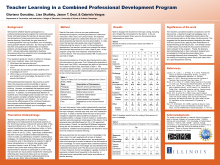Click image to see poster.
Abstract
We examine whether teacher participation in a professional development program that combined Lesson Study with discussions of videos and animations increased teacher noticing of students’ prior knowledge. Four questions guide our inquiry in relation to changes over time in teachers’ video club discussions:
1. What topics do teachers discuss?
2. How does attention to student thinking change?
3. In what ways do teachers consider students’ prior knowledge?
4. Who brings up considerations about student thinking and students’ prior knowledge, the teachers or the facilitators?
We expected that teachers would increase their attention to student thinking in subsequent sessions. In addition, we anticipated that attention to students’ prior knowledge would increase over time. The fourth question considers whether teacher noticing results from teachers’ initiative.
Theoretical Underpinnings: Teacher noticing refers to the process of teachers attending to and making sense of particular aspects of the “blooming, buzzing, confusion of sensory data” of the classroom (Sherin et al., 2011, p. 5). This process is of upmost importance since what teachers notice, or fail to notice, impacts their instructional decisions (Lampert, 2001; Sherin & van Es, 2002). Viewing video provides opportunities for teachers to participate in a community that promotes an inquiry stance and can increase teachers’ noticing of students’ mathematical thinking (Sherin & Han, 2004; Star & Strickland, 2008).
Methods: We examined discussions of six video clubs in year 1. The discussions totaled 196 minutes and 4 seconds. Following the example of Sherin and Han (2004), we analyzed the topics of discussion and initiators. Three coders independently examined the transcript and the video to identify when the topic changed, what the topic was, and who initiated the topic. Final segments were identified based on 2/3 or 3/3 agreement. An increased focus on student conceptions, initiated more frequently by the teachers, would serve as evidence of teacher learning.
For each segment with a topic of student conceptions or the common lesson plan, we looked for evidence discussion about prior knowledge. We also identified who initiated the discussion and if the discussion was substantial or trivial. Evidence of prior knowledge in a greater number of segments, initiated more frequently by the teacher, or discussed more substantially would serve as evidence of teacher learning.
Results: Table 1 displays the results from the topic coding. In the six discussions reviewed, there were no discussions about mathematics or discourse.
Significance of the Work: The teachers considered student conceptions in all the discussions. A teacher brought up pedagogy once. The teachers initiated discussions about the lesson plan in all discussions. This suggests that the teachers integrating the video club and Lesson Study, applying their observations of student thinking to the lesson. The limited number of other topics shows that the discussions centered on relevant topics. Finally, the teachers demonstrated growth in their noticing of students’ prior knowledge by initiating discussions about prior knowledge frequently and substantially. The study shows the viability of combining Lesson Study and video clubs for supporting teacher learning.
References:
Lampert, M. (2001). Teaching Problems and the Problems of Teaching. Yale University Press, New Haven, CT.
Sherin, M. G., & Han, S. Y. (2004). Teacher learning in the context of a video club. Teaching and Teacher Education, 20, 163-183.
Sherin, M.G., Jacobs, V.R., & Philipp, R.A. (2011). Situating the study of teacher noticing. In M.G. Sherin, V.R. Jacobs & R.A. Philipp (Eds.), Mathematics teacher noticing: Seeing through teachers’ eyes (pp. 3-13). New York, NY: Routledge.
Sherin, M.G., & van Es, E.A. (2002). Using video to support teachers’ ability to interpret classroom interactions. Proceedings of the 13th annual meeting of the society for information technology and teacher education (pp. 2532–2536). Norfolk, VA: Association for the Advancement of Computing in Education.
Star, J.R., & Strickland, S.K. (2008). Learning to observe: Using video to improve preservice mathematics teachers’ ability to notice. Journal of Mathematics Teacher Education, 11, 107-125.
